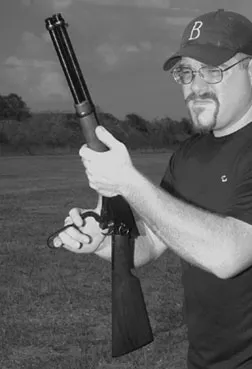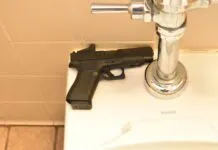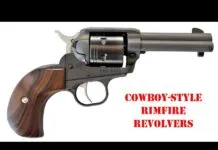
When it comes to choosing a defensive weapon, there are as many choices as there are applications. But how about a firearm that is more powerful than a handgun, more controllable than a shotgun, and easier to handle than a full-sized rifle? Add economical to buy and feed as desirable characteristics, and you have our choices for this test.
We recently got three handy carbines, two lever actions and one autoloader, chambered for .44 Magnum. Why .44 Magnum? Because for most people, the .44 Magnum creates too much recoil in a handgun, but is not nearly as punishing when chambered in a shouldered weapon. Yet the .44 Magnum has plenty of self-defense potential, but less “shoot-through” problems that standard rifle cartridges might cause in a home or apartment protection situation. Our test guns included two short lever actions, the $591 Marlin 1894 and the $458 Winchester Model 94 Trapper. We also found a $702 semi-automatic by Ruger, the 99/44 Deerfield.
The lever-action models would function with .44 Special ammo, but the Deerfield would not cycle the shorter rounds, so we limited testing to magnum ammunition. Our choices were 180-grain JHP rounds from PMC, 270-grain GDSP rounds by Speer, and 300-grain JHP/XTP rounds from Hornady. We bench-tested the guns for accuracy at 50 yards at American Shooting Centers in Houston, shooting them off Protektor leather bags front and rear.
Also, to evaluate the guns’ self-defense capability, in particular ease of target acquisition and elapsed times between follow-up shots, we set up a Hoffners ABC16 humanoid silhouette type target (hoffners.com) at 10 yards and from port arms delivered five strings of three rapid-fire shots. This drill was engaged five times for a total of 15 shots on target. The point of aim was the chest area, with hits counting within any vital area. We also looked at characteristics such as magazine capacity and the ability to reload under stress. We also considered the availability of aftermarket parts to enhance performance.
Eyes and ears everyone, this test made some noise.
If one of your first firearms was a Ruger 10/22 rifle, then you will feel right at home with the 99/44 Deerfield. Walnut stock, right-side access to the bolt lever, and a rotary magazine were but a few of the physical similarities.
The gold bead front sight was dovetailed into the front sight base that wrapped around the barrel secured by a roll pin. The 18.5-inch barrel with 1:20 inch right-hand twist was connected to a gas-operated semi-automatic action that was fed from a four-round rotary magazine. The rear sight was a flip-up peep sight that was adjustable for windage by drift. We adjusted for elevation adjustment by loosening two screws located on the face of the rear blade and sliding this calibrated piece up or down. The entire rear unit was held in place by an Allen screw and could be removed entirely.
The top of the bolt assembly was machined for mounting Ruger’s proprietary scope rings. Supplied were a set of 1-inch high-mount rings, part number S100RH, but other styles are available, such as 30mm, low, medium, extra-high, and offset. Weaver two-piece adaptable scope mounts are also available aftermarket.
The safety consisted of a crossbolt operated by a button located at the upper front corner of the trigger guard. The trigger itself was wide and smooth and broke at 4.5 pounds of resistance.
Our first test was to determine the level of [PDFCAP(2)] the Ruger 99/44 brought. We began with the PMC 180-grain rounds, and, frankly, we were not impressed. The power was there, as much as 1777 foot-pounds of muzzle energy on average, but we had to work extremely hard to land 50-yard groups measuring less than 2 inches across. Our single best group of 1.6 inches brought the average down to 2.1 inches, but most shots indicated that accuracy in the 2.5-inch range for five shots was the norm. The 99/44 also seemed to hit very high on target with this round.
When we loaded the Ruger with the Speer GDSP ammunition, we were greatly encouraged. Both the Speer and Hornady rounds brought in average groups of about 1.5 inches, and with the rear-sight elevation returned to center, the Ruger shot to point of aim. We think the addition of a scope would have further reduced group size because the front bead covered so much of the target. In our estimation, our best group overall, measuring 1.2 inches firing the Speer ammunition, was pretty close to optimal for this arrangement.
In terms of speed we subdivided our scoring into target acquisition and shot-to-shot elapsed time. The elapsed time between shots varied from a smoking 0.18 seconds to 0.34 seconds, for an average elapsed time of 0.27 seconds. What turned out to be the most limiting factor was sight acquisition. Getting our eyes into the little peep sight was not easy, especially for the first shot, which was fired on average about 1.65 seconds after the start signal from our Competition Electronics timer.
Length of pull on each of our carbines was 13.5 inches. But after the speed test we tried adding a Choate buttpad, which increased LOP on the Ruger by one full inch, ($21, from brownells.com). We think this helped us get into position faster and made shooting more comfortable. But for faster acquisition and greater accuracy, we would recommend adding a scope with a bold reticule or a red dot, which we think would be quickest of all.
Another shortcoming of the 99/44 carbine was magazine capacity (4+1). The Ruger was a very pleasing weapon to shoot, but two or three quick bursts and the fun was over. Reloading was not difficult for left- or right-handed shooters while keeping the carbine shouldered and on target. But the process was slow because the empty magazine would not drop free. The same hand must remove the magazine, acquire a fresh one and then place it in the weapon. We have seen drop-free magazines releases on competition 10/22 rifles, but have not yet heard of this modification being available for the .44 Magnum model.
[PDFCAP(3)]
The Winchester 94 Trapper was the shortest of our carbines. Overall length from its hard-plastic buttplate to the muzzle was almost 3 inches less than the Ruger and Marlin models. Its 16.2-inch barrel with 1:26 inch twist lined up nearly flush with the end of the nine-round-capacity magazine tube. The Trapper weighed only a few ounces less than the larger Marlin carbine, and the heft of its blue steel and dark wood, complemented by a saddle ring on the left sideplate, gave the impression of timeless hardware.
The thumb-operated tang-mounted safety slides forward for fire and back for on-safe. An additional safety feature was the pressure-operated safety that required the lever to be pressed flush to the stock before the trigger was free to move. With the tang safety activated, we were able to move the trigger and release the hammer, but the hammer was unable to contact the firing pin.
We found the action to be very light and easy to work, especially after the hammer has been moved back. Each of our lever-action carbines offered more loaded capacity than the Ruger, or many other weapons for that matter. But a speedy reload is pretty much out of the question, considering the one-at-a-time loading gate. Left-handed shooters will have an easier time topping off the magazine while keeping the gun shouldered, but the reload is an inherent sore point of the tubular magazine. Ejection of spent cases was angled to the right despite the breech-block riding centered atop the receiver. With each stroke of the lever we could see straight down into the feeding mechanism.
The front sight was dovetailed into the heavy wall of the barrel. The rear sight was also of a traditional, if not crude, design. To adjust for windage, the shooter would need to impact-drift the base of the rear assembly. Elevation adjustment was in two stages. To get rough elevation adjustment, the shooter slid a graduated step forward or back. To make fine adjustments, the shooter repositioned the rear blade up or down within its yoke. The top strap was drilled and tapped for mounting a scope. A two-piece scope-mounting system was the most obvious solution.
We began by shooting the Winchester from the bench and found that we liked the sights on this carbine best of all. The white triangle on the rear sight blade was very helpful in getting the proper index. Also, we did not have the impression that the front sight was covering a lot of target.
This didn’t help very much firing the PMC rounds, however, which delivered an average group of 2.6 inches per five shots. All shots fired featuring the 270-grain Speer rounds resulted in sub-2 inch groups. However, the Winchester became the star of the test overall when we landed five shots into one hole at 50 yards shooting the Hornady 300-grain JHP/XTP ammunition. We measured this collection of big bullet hits to be approximately 0.7 inches center to center. Average muzzle energy was 1273 foot-pounds, or a bulldozing power factor of 415 for Practical shooters who prefer that computation.
In our action test of sight acquisition and repeat fire, we learned three things. First, as expected, our splits between shots was slower than with the semi-automatic Ruger. Those splits averaged about 0.75 seconds for accurate shots on a 10-yard humanoid torso.
Second, our first shots with the Winchester were fast. Average first shot for the Ruger was about 1.4 seconds, but we were able to find the sights and fire about a quarter of a second quicker mounting the Winchester Trapper (1.175 seconds on average). This difference mainly reflects how the Ruger’s peep sight required getting the eye to look through an aperture rather than over the clear open sights on the Winchester. Of the three carbines in this test, we felt that the Winchester Trapper 94 was the only one that did not necessarily need the addition of a scope to make it faster or more accurate.
Third, we learned that the action of the Winchester could be short-stroked. That is, if the lever was not worked through its full range of motion forward and back, the spent round would be ejected but the fresh round would not be moved into the chamber. On three separate occasions the next round to be loaded actually popped out, leaving an empty chamber. We isolated two characteristics that could have contributed to this condition. The lever did have some play left and right, and the action of the lever itself was very light. Ideally, lightweight actions contribute to speed but without the shooter experiencing the sensation of mass coming to a stop, it is possible to mistake the end of the lever stroke and switch directions before cycling is complete. But without evidence of mechanical failure, we have to chalk this up to being a training issue.
[PDFCAP(4)]
The Marlin 1894 was a little bit longer and but only slightly heavier than the Winchester Trapper. Overall length was the same as the Ruger. The 20-inch barrel (1:38-inch right-hand twist) ran above a 10-round magazine. Marlin also produces an 1894C with an 18.5-inch 1:16 barrel, which holds one less round but is otherwise identical to our 1894 and sells for the same price.
The front sight was hooded to reduce glare and offered a white dot on a lined stanchion. The buttpad was rubber to absorb recoil. Both the stock and forend were American hardwood with diamond-pattern checkering. This lever action, like the Winchester, was fit with a safety that required holding the loop flush with the stock to release the trigger. But its operation was much less obvious, working with little if any distraction to the shooter. Also, a crossbolt safety at the rear of the receiver blocked the hammer from striking the firing pin.
Sight elevation of the rear sight employed a graduated sliding base. The face of the rear sight blade did not offer additional adjustment, but the sliding base offered many more positions than the Winchester’s. The 1894 had a right-side loading gate, and the breech-block moved underneath the top strap, ejecting spent shells to the right. The top strap consisted of a flat surface about 3 inches long. It was drilled and tapped for mounting a Weaver or Picatinny base. In our view, the Marlin offered more versatility in terms of scope mounting than did the Winchester. Overall, the Marlin was heavily built and should be durable. The action was fast and sure without any slop.
Our 50-yard bench rest session with the Marlin 1894 did not result in revelations of superb accuracy. The Marlin produced essentially the same accuracy with each of our test loads. The Ruger and the Winchester either liked a specific load or they didn’t. Theoretically, we could have dumped all our test ammunition into a bucket and picked any five rounds at random, loaded the Marlin and the result would be a 2.1-inch group.
This was remarkable because our testers rated the sight picture afforded by the Marlin to be the poorest of the three carbines. In our view, the Marlin would benefit most from the addition of a scope, and its flat top offered the easiest base to mount an optical unit.
In the rapid-fire test, we found that the Marlin was a little bit slower to the target than the Winchester, and we thought this was mostly due to the hooded front sight. Our average first shot on the 10-yard target took 1.32 seconds. Split times were slowed as well as we searched for sight alignment after working the lever. The average elapsed time between shots was 0.78 seconds.
Other Options
Previously, we have reviewed lever-actions for their hunting prowess or for their plinking or Cowboy competition use, not as self-defense options. But we have considered other pistol-chambered autoloading carbines as self-defense guns, so we do have some basis to compare these guns to others we’ve tested, even though there may be cartridge mismatches.
Kel-Tec Sub Rifle 2000 9mm Carbine, $383
The Kel-Tec Sub Rifle 2000 9mm Carbine, $383, reviewed in February 2003, arrived folded and measured 16.1 by 7.3 inches. Unfolded, it measured 29.5 inches in length with a 16-inch barrel. Weight empty was 4.6 pounds, magazine capacity was 10, the semi-auto action was blowback operated, and the gun had a trigger pull weight of 9.0 pounds and LOP of 13.1 inches. The trigger safety was a crossbolt design, and it is found above the web of the hand below the rear edge of the ejection port. Our best five-shot groups at 50 yards came from shooting Winchester USA (white box) 147-grain TCMC (truncated cone, metal case) ammunition into an average of 1.5 inches. The remaining test cartridges, Winchester’s USA 115-grain hollowpoints and Federal’s 124-grain expanding metal jackets, each shot groups averaging 2.5 inches. With a high of 1315 fps and muzzle energy of 442 foot-pounds, we’d opt for the power of the 115s.
Hi-Point 995 9mm Carbine, $199
The Hi-Point 995, reviewed in February 2002, came with ghost ring sights and a pistol-grip stock that houses a 10-round single-column magazine. Its unloaded weight was 6 pounds, with a 10+1 capacity, semi-automatic blowback action, a trigger pull of 7 pounds, an overall length of 31.5 inches, a barrel length of 16 inches, and an LOP of 14.5 inches. The Hi-Point 995 averaged group sizes ranging from 1.5 to 1.8 inches from our 50-yard bench rest. The smallest groups measured 1.1 and 1.0 inches with the Winchester 147-grain FMJ Subsonic and the Winchester 115-grain FMJ rounds, respectively. We have to credit this accuracy to the ghost ring sights and the trigger, which was short and consistent without creep.
Gun Tests Recommends
• Winchester Trapper 94 .44 Magnum, $458. Our Pick. We liked its short, compact feel and the supplied sights provided the most speed and accuracy. The action was light enough to short stroke, but we think familiarity was the key to reliable fast action shots. It delivers as much self-defense functionality as the two defense-dedicated 9mm carbines, offering slightly more power in exchange for faster 10-shot reloads.
• Ruger 99/44 Deerfield .44 Magnum, $702. Don’t Buy. We’re sure that for its primary use, the Deerfield would be a fine deer whacker, especially if fitted with appropriate optics. We thought the gun was fast handling, reliable and eager to cycle. But for us, the 99/44’s high price, limited capacity, slower first-shot acquisition, and slow magazine change speed puts it behind the Winchester Trapper .44 Magnum and the two previously reviewed 9mm carbines as a self-defense gun.
• Marlin 1894 .44 Magnum, $591. Don’t Buy. Reviewed in the context of self defense, we believe the Trapper simply outdoes the Marlin overall. To its credit, the Marlin was very consistent and we think the addition of a modern tactical scope could make this weapon a superior choice for high-power, low-cost defense. But because the Winchester costs less and does more, we wouldn’t buy the Marlin unit. Other shooters may disagree and see this as either a Conditional Buy- or a Buy It-rated gun, but to our eyes, the Trapper is lighter, shorter, faster to target, cheaper, and more accurate with selected ammo.


























